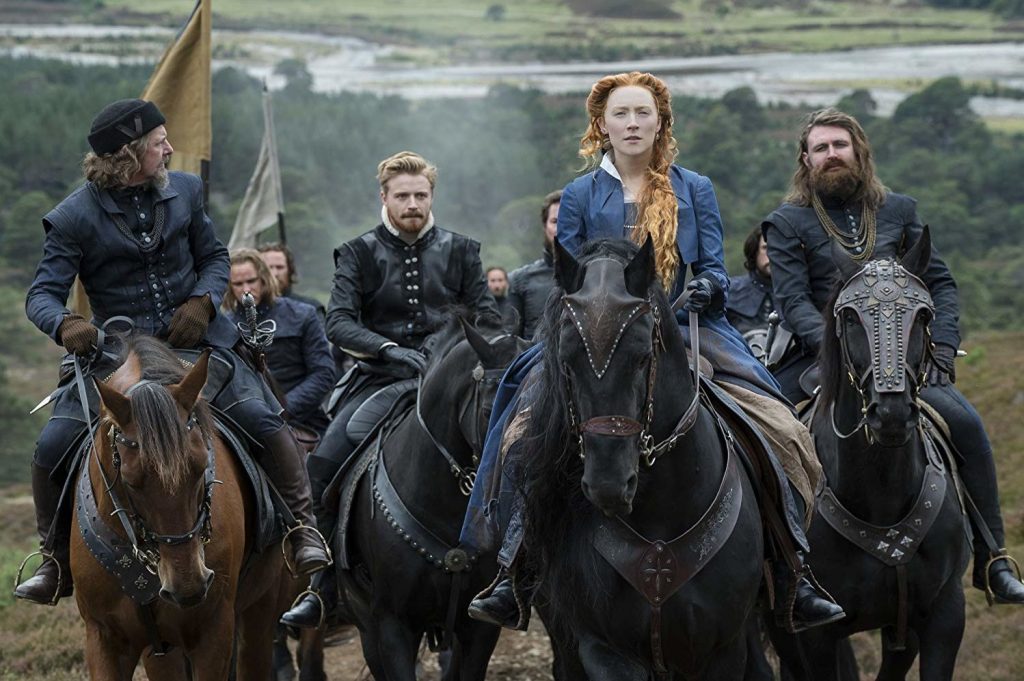Sexual intercourse, Philip Larkin wrote, was invented in 1963, ‘between the end of the Chatterley ban and the Beatles’ first LP.’ Cunnilingus, according to Josie Rourke’s Mary Queen of Scots, was brought to Scotland in 1565 by a silver-tongued seducer named Robert, Lord Darnley, who seems to have acquired a taste for it at the court of Elizabeth I.
The invention of intercourse, Larkin wrote, came ‘rather late for me’. But in Rourke’s telling, cunnilingus arrives north of the border just in time for Mary. She marries Darnley and, despite the obstacle of his alcoholism and homosexuality, bears him a son. In 1603, when Elizabeth I dies without issue, Mary’s son, a feeble and tyrannical slobberer obsessed with witches, becomes James I of England. Thus Mary, who has been beheaded by Elizabeth for intriguing against the English throne, posthumously defeats her southern neighbor.
While we’re on the historical preliminaries, Mary, Queen of Scots, a redhead Catholic who married a French prince must not, on pain of being burnt at the stake, be confused with her cousin Mary, Queen of England, a redhead Catholic who married a Spanish king. Neither should be confused with Elizabeth I, the red-headed Protestant who was Mary, Queen of England’s younger sister and Mary, Queen of Scots’s older cousin.
We should, however, confuse Joe Alford, who plays here Elizabeth’s favorite love-interest, the Earl of Leicester, with Joe Alford, who plays the love interest in The Favourite. We might confuse the opening of Mary Queen of Scots — Mary falls into the surf after disembarking from a boat as a child watches — with the opening of Jane Campion’s The Piano. We might also confuse further elements of Josie Rourke’s film — the sweeping highland vistas of Braveheart, the granite castle used so well in Outlaw King, the courtiers dressed as dogs at a fire-lit court ball in Wolf Hall — with other films.
Mary Queen of Scots is a historical Instagram feed, jamming other people’s images into a reflection of current vanities. We may struggle to comprehend the religious and political violence of the 16th century, but Mary Queen of Scots shows that some of us are in the grip of no less unhinging enthusiasms. Mary (Saoirse Ronan) is not a Catholic fanatic who denies Elizabeth’s legitimacy because she is Protestant, misplays her hand among the schismatic Scottish nobles, and then ends up seeking Elizabeth’s protection. Mary is a pioneer of interfaith tolerance. She runs a gender-fluid court. ‘You’re safe here with us,’ she tells her trans lute player, and accepts him as her ‘sister’. She is a free-bleeder who delivers her son in the Scottish equivalent of the women’s hut, with no male doctor in sight. She wants peace, not a little piece of France and a big piece of England.
Elizabeth (Margot Robbie) is out of touch with her sexuality, and the English court is rigidly cisgendered. Elizabeth is punished for this by being infected with smallpox, leaving scars that are the virtue-signal equivalent of the Mark of Cain. Elizabeth is not attractive. She must be a bad person. Mary, though, retains her hotness, especially when Lord Darnley goes south of the border. That’s why she wins in the end, by getting her head chopped off. Elizabeth and Mary have one scene together, but Rourke blows it by staging it in a laundry. They wander about with linen flapping in their faces. When they finally come face to face, Elizabeth admits she is jealous of Mary, and that she should give her the English throne on grounds of hereditary hotness.
What is the point of setting a historical drama in Scotland, one of the palest places on the planet, and spending lots of money on costumes and candles, and then populating the film with non-white faces? Elizabeth has a lady-in-waiting of East Asian extraction, Mary has one of vaguely African descent. Both are attended by nobles of deeply African appearance.
We are supposed not to notice this, but the whole point of it is that we do notice it, and then congratulate ourselves on not noticing it because we are blind to color. This is a politically correct form of vanity, with the added dividend of setting up anyone who objects as a racist. But it is distracting. What happened to the hereditary Afro-nobility of Scotland? Are they still there, smoking salmon in a glen that doesn’t have WiFi?
This cyclical deployment of black faces is fetishistic. The two leads are pale redheads, as white as they come. Rourke cannot resist planting a mute black man at their shoulders, because it sharpens up the visual palette. Today’s piety is yesterday’s errors, reversed but bearing the imprint in negative.
Whoever cast this film should be suspended in a gibbet at the gates of Edinburgh until the crows hath taken their innards for carrion. Never have so many actors looked ashamed. Guy Pearce, as Elizabeth’s adviser Lord Cecil, is mortified in a daft wig. David Tennant, as the Calvinist ranter John Knox, begs for rescue from behind a comedy beard. Saoirse Ronan and Margot Robbie would each have been better in the other’s role. When Mary walks to the scaffold, Simon Russell Beale looks aghast as he reads the sentence, not because he is distressed at a judicial killing, but because his agent has trapped him in a turkey.
We can learn a bit of history from costume dramas, but they teach us more about our own time. Mary Queen of Scots is pious, hypocritical, shallow, and parasitic upon earlier work. Nor is its anachronism redeemed by candor or wit, as when Tony Curtis delivered Arabian Nights kitsch in a thick Brooklyn accent in Son of Ali Baba (1952): ‘This is da palace of my fadda, and yonder lies da Valley of da Sun.’
Dominic Green is Life & Arts Editor of Spectator USA.


















